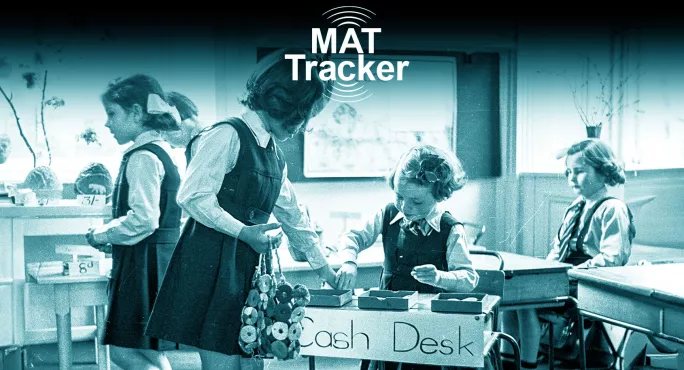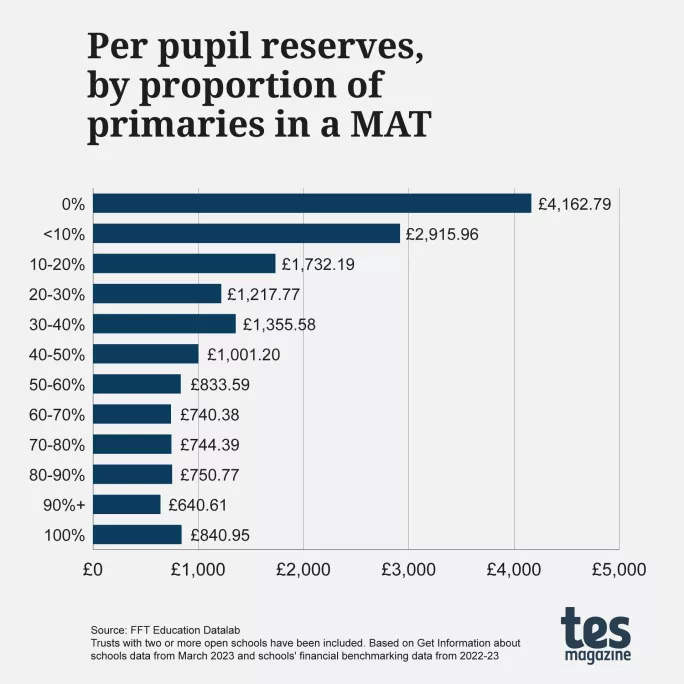The ‘perverse incentives’ facing primary MATs

The vast majority of schools sitting outside of multi-academy trusts (MATs) are primaries (81 per cent), making them pivotal in any future growth of the MAT sector.
But there are concerns that decisions over where these schools end up - and the longer-term landscape for MATs - could be overly swayed by financial pressures rather than the interests of schools, trusts and pupils.
Underscoring this financial pressure is the fact that trusts with no primaries have nearly five times the average revenue reserves per pupil than all-primary trusts, according to analysis by FFT Education Datalab for Tes.
‘Perverse incentives’
Oliver Burwood, CEO of the Diocese of Norwich Education and Academies Trust (DNEAT), says the FFT data shows that funding for primaries needs to be re-examined.
“At the moment, it creates perverse incentives,” he told Tes. “I know of MATs who are really wanting to be primary-focused but they’re having to seek to take on secondaries because they want that funding boost.”
FFT’s analysis of the latest accounts from 2022-23 found that, on average, all-primary MATs had £840.95 in revenue reserves per pupil, compared with £4,162.79 for MATs with no primary schools.
- Regional board highlights: Pre- and post-election decisions
- Related: Demand soars for ‘emergency’ school improvement cash
- MAT Tracker: Mapping the country’s multi-academy trusts
The differences do not appear to be down to disparities in trust size. For example, all-primary MATs still had significantly lower per-pupil reserves than MATs with no primaries when FFT split the data by MATs with five or fewer schools and 10 or more schools.
Additionally, the analysis found that 61 per cent of all-primary MATs had a negative in-year balance in 2022-23, compared with 36 per cent of MATs with no primaries.
The picture is slightly mixed, for example, the lowest average reserves - of £640.61 - are among MATs at which 90 per cent of schools cover the primary phase.
Meanwhile, in mixed MATs, trusts have increasingly been forced to cross-finance their primary schools to maintain financial viability.

Why are primary finances so stretched? There are huge pressures on the sector as a whole, such as spiralling costs associated with special educational needs and disabilities, supply and energy - but primaries are often also challenged by falling rolls and increasing demand for support staff.
And, under the National Funding Formula, the minimum per pupil funding level is £4,610 for primaries, compared with £5,995 for secondaries.
Collectively, these create significant challenges for the more than 9,000 local authority-run primaries, as well as the 408 all-primary MATs with at least two schools, and 357 primary single-academy trusts (SATs).
Gail Brown, CEO of Ebor Academy Trust, which has 25 primary schools in Yorkshire, says demands on schools, particularly with younger children, are only rising.
“But because of the funding difference, we are really having to cut to meet our needs,” she tells Tes.
“It is fundamentally vital to consider increasing funding in early years and primary because that’s when most of these needs can be identified and met.”
Funding challenges presented by small primaries
Funding is particularly difficult for small primary schools.
Nicky Dunford, CEO of the Link Academy Trust and chair of the National Small Schools Group, says the amount of funding, rather than the management of funding, is one of the things members “really struggle with”.
Her group was due to discuss this with former academies minister Baroness Barran earlier this summer “but then the election was called and everything stopped with the pre-election period”, she says.
Dunford’s trust has 23 primary schools in Devon, many of which are small, with their full capacity at around 50 pupils. Three such schools joined the trust last academic year out of five joining in total.
“We won’t be able to grow anymore for a while now until we settle the new schools down,” Dunford tells Tes. “If we took on any more schools they would have to be in a different position financially.”
Despite the funding challenges presented by small primaries, many trust leaders still believe in their value.
Ebor has 10 schools with fewer than 100 pupils, but Brown says it is very important for the local communities those schools serve that they remain open. She believes her trust has a model that enables these schools to remain viable with high standards of education for all children.
Several trust leaders tell Tes they are increasingly using shared heads across small schools to make them viable.
Number of all-primary MATs falling
However, a separate Tes analysis of Department for Education data finds the number of all-primary MATs is falling slowly, with a 5 per cent drop between October 2023 and 2024.
This is happening faster than the fall in the overall number of MATs, which saw a 3 per cent drop between October 2023 and 2024.
Some leaders see opportunities in cross-phase MATs unrelated to finances, such as providing an all-through education in the community, sharing expertise and resources across phases, smoother transitions, and improved succession planning.
But others warn against taking on secondaries for purely financial reasons when trusts may lack the necessary expertise.
Different ‘skill set’
DNEAT, which is based in Norfolk, has 41 primary schools and one secondary: many of the primaries have fewer than 100 children.
Burwood says despite finding the funding situation “poor over the last couple of years”, the trust does not intend to seek out secondaries to grow.
“That’s not my skill set as a leader or my team’s - our secondary is small so it’s very different,” he added.
“I’m sure there are MATs with a few big secondaries that feel they can’t let go even though they’re primary-focused. And that’s a concern because it would stop schools going to the right place if a trust holds on to it for financial rather than moral reasons.”
Ebor transferred out a small secondary school from the trust a few years ago, which Brown says was needed to allow it to go to a trust with the capacity to provide for it and maintain Ebor’s expertise in primary.
“It’s an unwise view to look at secondaries just as the financial propagator of primaries,” she says. “Education is about the quality of your teachers, the quality of broad education the children receive and the expertise the trust can bring.”
Trust mergers
There is no doubt that the whole sector is feeling the pinch; Tes revealed earlier this year there had been a 42 per cent year-on-year increase in trusts falling below the DfE reserves threshold.
Nonetheless, secondary schools can be more financially resilient, says Mark Blackman, director of education consultancy Leadership Together, adding: “I think in the system there is a trend towards balancing primary and secondary.”
Trusts are unlikely to come by secondaries as a result of conversions: there are a dwindling number of secondary schools left to academise.
Of the more than 10,000 local authority-maintained schools, just 571 (5 per cent) are secondaries and 9,158 (84 per cent) are primaries. The rest are special schools, alternative provision settings and nurseries.
Mergers with cross-phase MATs may be a more feasible option for all-primary MATs wishing to diversify.
“Trusts are absolutely thinking about mergers in order to have larger, more financially resilient operations, but also better school improvement,” says Blackman.
However, larger MATs “have to think quite hard about school improvement, estates and managing IT”, Blackman cautions. “You need a bigger central team the bigger the MAT gets - and that can use up reserves.”
Under the previous government, the system was thought to be moving towards encouraging many smaller trusts or single-academy trusts to merge or join larger MATs, although Labour appears to be more agnostic.
Orphan schools
As the MAT sector consolidates, there are longstanding fears for a group of primary ”orphan schools” that risk being left behind.
“There’s no incentive for anyone to take them on,” says Burwood. “The problem of primaries not having enough funding is compounded as the amount you get in for improvement is so low it costs the trust more.”
Labour has announced the introduction of regional improvement teams, which it hopes will better support struggling schools.
Burwood adds that he would also like to see regional directors “use their levers of commissioning better” to support trusts willing to take on small struggling schools that may have difficult finances.
“It’s quite clear some trusts have made decisions about not taking on particular kinds of schools for financial reasons,” says Dave Baker, CEO of Olympus Academy Trust, which has nine schools in the South West.
“But there are also many trusts that are clear they want to be primary-only,” he says. “If you were to ask regional directors about commissioning in particular areas, they will probably tell you they need more primary-only trusts in some areas but not overall.”
More funding for primaries ‘benefits secondaries long term’
To help stabilise all-primary MATs, leaders say the amount of total funding and the way it is distributed will need to change.
The DfE has calculated that the average primary to secondary per pupil funding ratio across all local authorities in 2024-25 is 1:1.296. This means, on average, secondaries receive nearly 30 per cent more funding than primaries.
Ebor would receive an increase of more than £8 million a year in general annual grant funding alone if primaries were funded at the same level as secondaries, Brown says.
“If we were funded at that level, we could make it work swiftly, which would ultimately benefit those in secondary in the long term,” she added.
The DfE was contacted for comment.
FFT’s analysis only included MATs with two or more open schools and also combined figures for individual schools within a trust and central services.
For the latest education news and analysis delivered every weekday morning, sign up for the Tes Daily newsletter
Keep reading for just £1 per month
You've reached your limit of free articles this month. Subscribe for £1 per month for three months and get:
- Unlimited access to all Tes magazine content
- Exclusive subscriber-only stories
- Award-winning email newsletters
topics in this article



